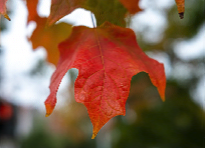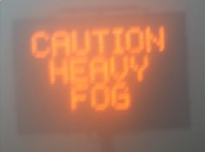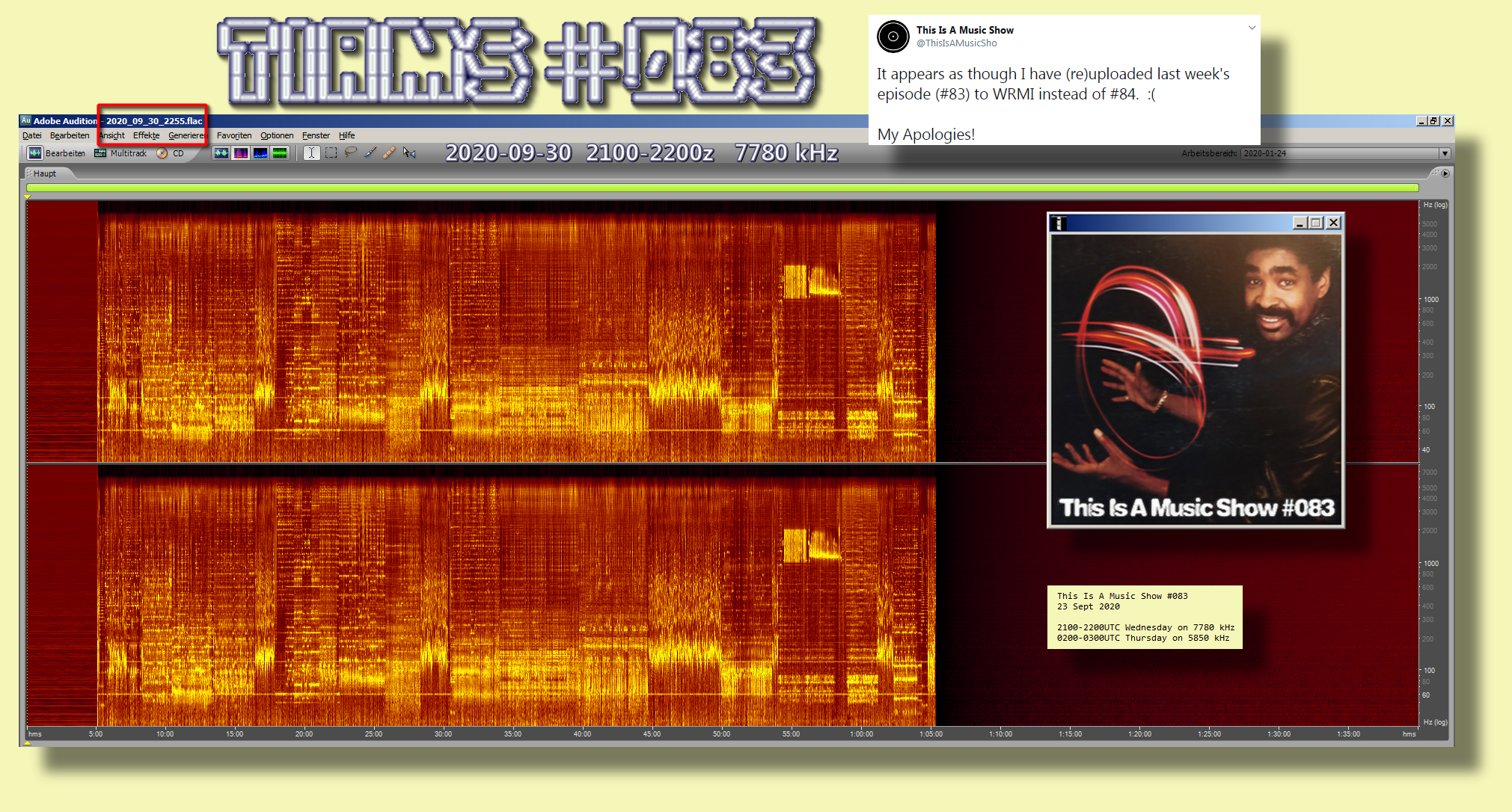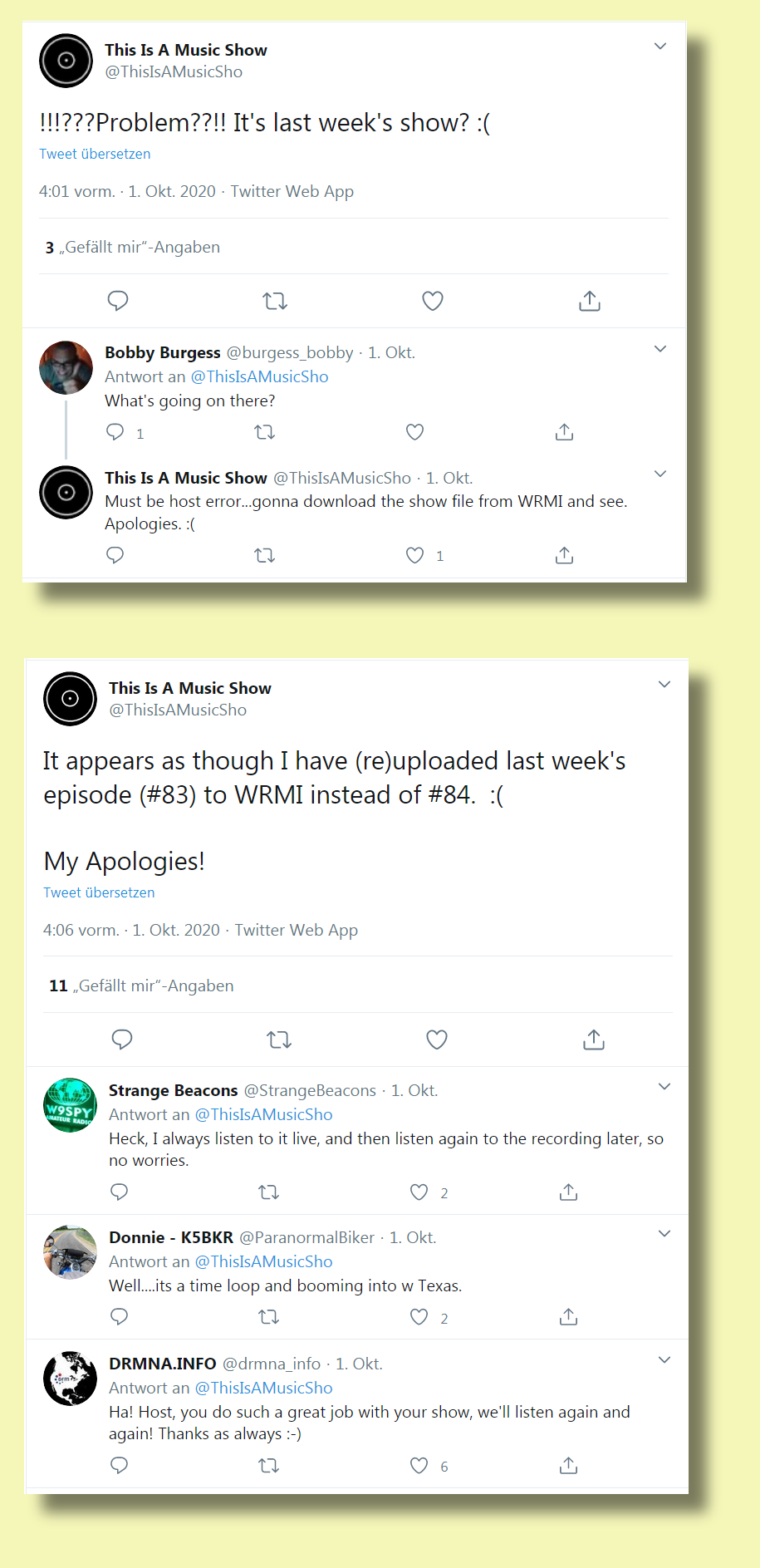http://www.rhci-online.net/radiogram/radiogram.htm
|
RSID: <<2020-10-04T01:30Z MFSK-64 @ 5960000+1500>>
|

http://www.rhci-online.net/radiogram/radiogram.htm
|
RSID: <<2020-10-04T01:30Z MFSK-64 @ 5960000+1500>>
|

RSID: <<2020-10-01T23:31Z
MFSK-32 @
9265000+1500>>
Welcome to program 172 of Shortwave Radiogram.
I'm Kim Andrew Elliott in Arlington, Virginia USA.
Here is the lineup for today's program, in MFSK modes as noted:
1:46 MFSK32: Program preview (now)
2:48 TikTok launches US election guide
5:29 MFSK64: Next NASA Mars rover will be target for lasers*
11:49 This week's images*
28:25 MFSK32: Closing announcements
* with image(s)
Please send reception reports to
radiogram@verizon.net
And visit http://swradiogram.net
Twitter:
@SWRadiogram
From the Vouce of America:
TikTok Launches US Election Guide
VOA News
29 September 2020
Chinese-owned video sharing platform TikTok says it is creating a
guide "to protect against misinformation" during the 2020 U.S.
elections.
In a blog post Tuesday, the company said its guide would connect
"100 million Americans with trusted information about the
elections from the National Association of Secretaries of State,
BallotReady, SignVote, and more."
"Our elections guide is built with user privacy in mind, so a
user must visit the website for a state or a non-profit for
anything that involves sharing their information, including
registering to vote," Michael Beckerman, TikTok's head of U.S.
public policy, said in the blog post. "Interactions with this
guide in our app have no bearing on future TikTok experiences,
such as recommendations or ads."
TikTok, which is especially popular with younger people, is owned
by ByteDance, a Chinese company.
TikTok has sought to alleviate U.S. concerns over privacy issues
by forming a partnership with two U.S. companies, Oracle and
WalMart. The deal has not been finalized, and there have been
conflicting statements among the parties about how much of the
new venture each company would own.
The Trump administration was moving forward to ban TikTok from
app stores, but on Sunday, a judge blocked an order to prevent
app stores from distributing it.
The judge gave lawyers for TikTok and the administration until
Wednesday to meet and propose a schedule for further proceedings
in the case.
Shortwave Radiogram changes to MFSK64 ...
RSID: <<2020-10-01T23:35Z
MFSK-64 @
9265000+1500>>
This is Shortwave Radiogram in MFSK64
Please send your reception report to radiogram@verizon.net
From New Atlas:
NASA's Perseverance rover will be a target for orbital lasers
Anthony Wood
29 September 2020
When NASA's Perseverance rover touches down on Mars in February
2021, it will carry with it a set of pristine mirrors that will
serve as targets for future orbital spacecraft equipped with
high-precision lasers. The laser-bouncing experiment could help
scientists understand how gravity affects the alien world, and
may one day make the hazardous job of landing autonomous probes
on the Martian surface a safer prospect.
Since the advent of the space age in the 1950s, scientists have
been busily thinking up ingenious ways of unraveling the secrets
of the myriad worlds that make up our solar system. They have
invented a veritable arsenal of equipment, from complex
spectrometers capable of separating light into its constituent
parts to magnetic field sensors and high-tech cameras designed to
capture surreal and breathtaking cosmic scenes.
But sometimes, if you really want to get to know a world, nothing
beats putting a shiny mirror on it and hitting it with a laser.
Peak science.
During the Apollo-era astronauts placed a series of large
reflective arrays on the lunar surface, some of which were about
the size of a computer monitor. Researchers back on Earth then
fired lasers at them - with impressive accuracy – and counted how
long it took for the beam to return.
These exquisitely simple experiments allowed scientists to keep
track of the Moon's orbit and its shifting shape as it was
squeezed by Earth's gravitational influence. One of the strengths
of the retroreflectors is that, if undisturbed, they can remain
useful reference points for decades. As a case in point, the
mirrors placed on the Moon during the later Apollo missions are
still used by researchers to this day.
Now, NASA is looking to repeat these experiments on Mars, but
instead of shining a laser from Earth, the rover-mounted mirrors
will be targeted by spacecraft high in orbit over the Red Planet.
The retroreflectors carried by the Perseverance rover are also
much smaller than those used during the Apollo missions, and
follow a completely different design.
The mirrors deployed during the Apollo 11 and 14 missions took
the form of bulky, flat panels. The new generation of reflectors
are much smaller, encased within a 2 inch (5 cm)-wide protective
dome. Each of the small holes pitting the casing houses three
mirror faces that sit at a 90-degree angle to one another.
According to NASA, this technique ensures that a laser fired into
the device will be directed directly back at its source.
Similar reflectors will also fly with NASA's InSight lander and
ESA's upcoming Rosalind Franklin rover, which is set to launch in
2022.
The experiment is a good example of how space agencies seek to
cram as much science as possible into a mission, to ensure the
greatest scientific output. The reflector won't actually be used
for years after Perseverance touches down on the Red Planet, as
no spacecraft currently in orbit are equipped with a ranging
laser. Instead, this particular part of the rover's arsenal will
have to wait for a future laser-toting robot to come along.
Once such a mission does fly overhead, NASA will be able to
gather detailed information on the position of the rover. With
this scientists could test how the Red Planet's orbit is affected
by the Sun's mass. The data could also be used to understand how
the Martian terrain shifts over time in numerous locations.
On a more practical note, mirrors could one day be used to make
landings on the Martian surface safer by providing points of
reference. Depending on celestial positions and the distribution
of satellites, it takes somewhere between four and 24 minutes for
a radio signal sent from a spacecraft around Mars to reach the
Earth. Because of this, it's impossible for humans to manually
oversee rovers as they make their hazardous final descent through
the Martian atmosphere.
Therefore, landings must be entirely pre-programmed and
autonomous. Perseverance will rely on Terrain-Relative Navigation
to get it to the ground – a clever new system that compares
images snapped by an onboard camera during descent with its
onboard map. If it deems itself to be in danger, the flight
computer can make a course adjustment in order to set the
extremely expensive piece of kit down on safer terrain.
In the future, mirrors placed on the surface could serve as a
valuable points of reference for these automated landing systems,
helping them avoid the ignominious fate of the poor explorers
that were a little too keen to meet the Martian surface.
It's worth noting here that the surface of Mars is radically
different from that of the Moon. The major difference is that the
Red Planet's diminished atmosphere is still capable of conjuring
up powerful weather systems which lift a lot of dust into the
air. Dust which is very good at adhering to surfaces and reducing
reflectivity.
Back in 2015 a global dust storm consumed Mars, causing the
storied Opportunity rover to permanently lose contact with its
handlers. Here's hoping that NASA's shiny new mirrors, along with
its equally shiny new rover, don't meet with a similar dusty
fate.
Source: NASA
https://newatlas.com/space/nasa-perseverance-rover-mars-laser/
Image: Artist's rendering of the cruise stage, now in progress,
of the NASA Perseverence mission ...
Sending Pic:190x195C;

This is Shortwave Radiogram in MFSK64
Please send your reception report to radiogram@verizon.net
This week's images ...
A duck swims in a pond during an autumn day in the town of
Chekhov, near Moscow. From
https://bit.ly/3ilMdzQ ...
Sending Pic:205x143C;

A bird over a mustard field searches for food in Daugendorf,
Germany. From
https://bit.ly/3l7YgCV
Sending Pic:200x113C;

"Bringing In The Catch" by George Hodgson, a winner of the 2020
UK sea view photography competition. From
https://bit.ly/3naSWAj
...
Sending Pic:240x296;
An art installation called 'Through', installed as part of a
public art trail for Kensington & Chelsea Art Week in London.
From
https://bit.ly/3jmVXeB ...
Sending Pic:201x134C;
A butterfly feasting on the nectar of carefully composed flowers
in France. From
https://bit.ly/3n2o1Gx ...
Sending Pic:107x211C;

The Glass Fire burns in the background as Josh Asbury, an
employee of CableCom, installs fiber optic cable in Calistoga,
California. From
https://reut.rs/36l2we4 ...
Sending Pic:208x150C;
Sunrise looking towards Waterfoot near Glasgow. From
https://bbc.in/34elsZk ...
Sending Pic:219x75C;

Signs of fall on Capitol Hill in Washington DC. From
https://wapo.st/3n5K9Qd ...
Sending Pic:205x148C;

Sign warns drivers of fog in Montgomery County, Maryland, 25
September. From
https://bit.ly/3jlQHYO ...
Sending Pic:205x152C;

Our painting of the week is "Vase of Flowers on a Red Cloth" by
Pierre Bonnard. From
https://bit.ly/36msON5 ...
Sending Pic:202x179C;

Shortwave Radiogram returns to MFSK32 ...
RSID: <<2020-10-01T23:58Z
MFSK-32 @
9265000+1500>>
This is Shortwave Radiogram in MFSK32 ...
Shortwave Radiogram is transmitted by:
WRMI, Radio Miami International, wrmi.net
and
WINB Shortwave, winb.com
Please send reception reports to
radiogram@verizon.net
And visit http://swradiogram.net
Twitter:
@SWRadiogram or
twitter.com/swradiogram
I'm Kim Elliott. Please join us for the next Shortwave
Radiogram.
|
Ending music: https://www.midomi.com/Track?trackID=100128525197505951&song=stop-and-smell-the-roses
Stop And Smell The Roses
|
http://www.rhci-online.net/radiogram/radiogram.htm
|
QTH: |
D-06193 Petersberg (Germany/Germania) |
|
|
Ant.: |
Dipol for 40m-Band & Boomerang Antenna 11m-Band |
|
|
RX for RF: |
FRG-100B + IF-mixer & ICOM IC-R75 + IF-mixer |
|
|
Software IF: |
con STUDIO1 - Software italiano per SDR [S-AM-USB/LSB] + beta 11 Version 2.80 (August 21, 2018) - for scheduled IF-recording |
|
|
Software AF: |
Fldigi-4.0.18 + flmsg-4.0.7 images-fldigifiles on homedrive.lnk |
|
|
OS: |
German XP-SP3 with support for asian languages |
German W7 32bit + 64bit |
|
PC: |
MEDION Titanium 8008 (since 2003) [ P4 - 2,6 GHz] |
MSI-CR70-2MP345W7 (since2014) [i5 -P3560 ( 2 x 2,6GHz) ] |
http://wiki.radioreference.com/index.php/Decoding_the_SW_Radiogram_Broadcasts
https://www.qsl.net/ve7vv/Files/Digital%20Modes.pdf

